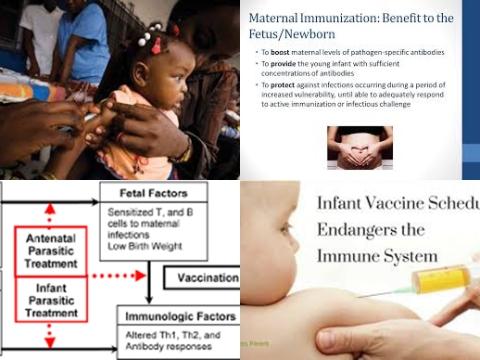
Objectives:
The design of infant immunization schedules requires an understanding of the factors that determine the immune response to each vaccine antigen. Therefore, this meta-analysis (review article) has been conducted.
Is there an association between maternal antibody concentrations and infant vaccine responses?
Study design:
This review article included a total of 7,630 infants of which 3,906 (51.2%) were boys from 32 studies in 17 countries.
Mean (SD) age at baseline was 9.0 (2.3) weeks. Preexisting maternal antibody inhibited infant antibody responses to priming doses for 20 of 21 antigens.
Antigen-specific antibody concentration measured 1 month after priming vaccine doses, before booster vaccination and 1 month after booster vaccine doses.
Results and conclusions:
The investigators found that the largest effects were observed for inactivated polio vaccine, where 2-fold higher maternal antibody concentrations resulted in 20% to 28% lower postvaccination antibody concentration [type 1, geometric mean ratio [GMR] = 0.80, 95% CI = 0.78-0.83 and type 2, GMR = 0.72, 95% CI = 0.69-0.74 and type 3, GMR = 0.78, 95% CI = 0.75-0.82].
The investigators found for acellular pertussis antigens, 2-fold higher maternal antibody was associated with 11% lower postvaccination antibody for pertussis toxoid [GMR = 0.89, 95% CI = 0.87-0.90] and filamentous hemagglutinin [GMR = 0.89, 95% CI = 0.88-0.90] and 22% lower pertactin antibody [GMR = 0.78, 95% CI = 0.77-0.80].
The investigators found for tetanus and diphtheria, the estimates were 13% [GMR = 0.87, 95% CI = 0.86-0.88] and 24% [GMR = 0.76, 95% CI = 0.74-0.77], respectively.
The investigators found the influence of maternal antibody was still evident in reduced responses to booster doses of acellular pertussis, inactivated polio and diphtheria vaccines at 12 to 24 months of age.
The investigators found children who were older when first immunized had higher antibody responses to priming doses for 18 of 21 antigens, after adjusting for the effect of maternal antibody concentrations. The largest effect was seen for polyribosylribitol phosphate antibody, where responses were 71% higher per month [GMR = 1.71, 95% CI = 1.52-1.92].
The investigators concluded that maternal antibody concentrations and infant age at first vaccination both influence infant vaccine responses. These effects are seen for almost all vaccines contained in global immunization programs and influence immune response for some vaccines even at the age of 24 months. These data highlight the potential for maternal immunization strategies to influence established infant programs.
Original title:
The Influence of Maternally Derived Antibody and Infant Age at Vaccination on Infant Vaccine Responses: An Individual Participant Meta-analysis by Voysey M, Kelly DF, […], Pollard AJ.
Link:
https://www.ncbi.nlm.nih.gov/pubmed/28505244
Additional information of El Mondo:
Find more information/studies on food fortification/malnutrition right here.